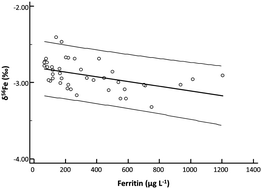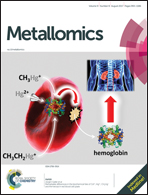Whole blood Fe isotopic signature in a sub-Saharan African population†
Abstract
The Fe isotopic composition of an individual's whole blood has recently been shown to be an interesting clinical indicator of Fe status. The present study aimed to evaluate the influence of several endemic characteristics of a representative population of the South Kivu province, an Fe-rich volcanic African region, on the whole blood Fe isotopic composition. Both diabetes mellitus and the ferroportin Q248H mutation are very common in Africa and are strongly associated with impairments in Fe metabolism. Fe isotopic analysis of whole blood samples was carried out using multi-collector inductively coupled plasma-mass spectrometry (after chromatographic isolation of the target element). Forty-two male subjects (between 48 and 59 years old) living in Bukavu (South Kivu) were enrolled in this study. Among the selected population, wild-type subjects and subjects presenting the ferroportin Q248H mutation (heterozygotes and homozygotes) were included. Within each group, diabetic and non-diabetic patients were considered. The whole blood δ56Fe value ranged from −3.09‰ to −2.41‰. The δ56Fe value shows a significant negative correlation with the ferritin concentration. No correlation could be established between the whole blood δ56Fe value and the transferrin concentration, transferrin saturation or serum Fe concentration. The ferroportin Q248H mutation did not seem to have affected the whole blood Fe isotopic signature. The whole blood δ56Fe values were significantly higher in diabetic subjects than in non-diabetic subjects and showed a significant negative correlation with body mass index (BMI) values.



 Please wait while we load your content...
Please wait while we load your content...